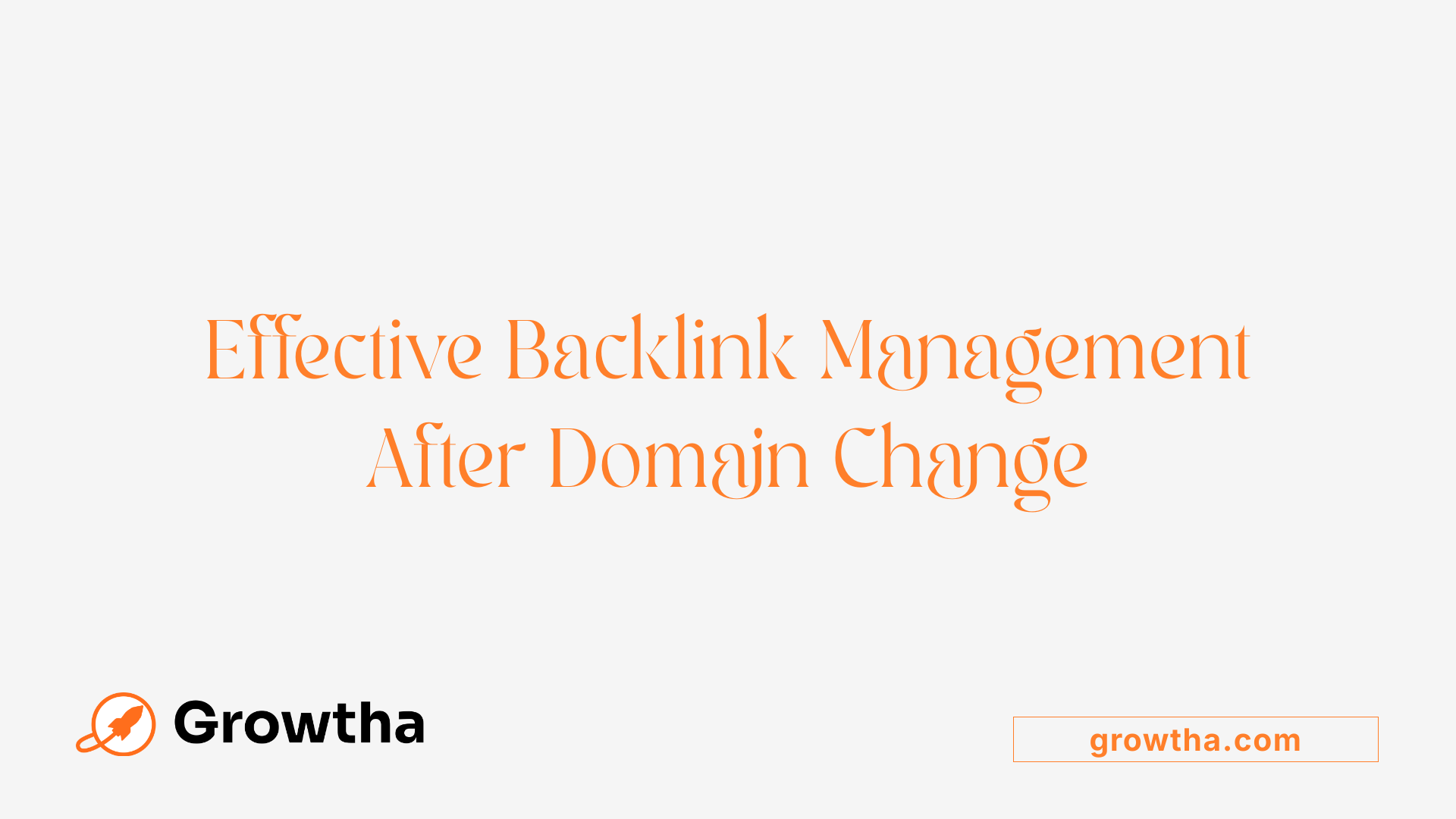Tips for SEO After Changing Your Healthcare Domain
Essential Steps for a Seamless Healthcare Domain Migration


Tips for SEO After Changing Your Healthcare Domain
Ensuring SEO Success During Healthcare Website Rebranding and Domain Transition
Changing your healthcare domain is a strategic move that can significantly impact your online visibility and patient engagement. To navigate this complex process successfully, it’s crucial to implement a comprehensive SEO plan that encompasses technical adjustments, content optimization, and reputation management. This article provides a detailed guide, emphasizing best practices for maintaining and enhancing search engine rankings post-domain change, with a focus on healthcare-specific considerations such as E-E-A-T principles, local SEO, and regulatory compliance.
Establishing a Solid Technical Foundation for SEO

What technical SEO considerations should be addressed during a healthcare website rebranding?
Rebranding a healthcare website involves crucial technical SEO steps that ensure continuity in search engine rankings, user experience, and compliance with healthcare standards. One of the most important actions is implementing proper 301 redirects from the old URLs to the new URLs. This preserves existing domain authority and prevents loss of traffic caused by broken links.
Updating sitemaps and ensuring they reflect the new site structure is essential. Submitting the updated sitemap to Google Search Console helps search engines understand the new architecture quickly. Managing crawl errors through tools like Google Search Console also ensures that search engines can access all relevant pages.
Page speed optimization plays a vital role, particularly for mobile users. Compress images, minify code, and leverage browser caching to reduce load times. Ensuring mobile responsiveness through flexible layouts and touch-friendly design enhances usability on smartphones and tablets.
Structured data markup, such as schema.org tags, should be incorporated to improve search listings with rich snippets, Trust signals, and FAQ sections relevant to healthcare. This not only boosts visibility but also supports regulatory compliance.
Maintaining consistent and accurate Name, Address, and Phone Number (NAP) details across online directories, particularly Google My Business, enhances local SEO. Ensuring these details are correct and uniform helps local patients find your practice easily.
Besides on-page and off-page SEO, updating social profiles, author bios, and internal linking structures maintains site integrity and authority. Regular technical audits, including checking for duplicate content, crawl errors, and site security issues, are necessary for ongoing health.
In summary, adopting a comprehensive approach to technical SEO during rebranding involves redirect strategies, sitemap management, speed enhancements, mobile optimization, structured data, and local details. These measures collectively support improved search rankings, a seamless user experience, and regulatory adherence, forming a robust foundation for a healthcare website’s new identity.
Preserving and Enhancing Link Equity and Backlinks

How can healthcare providers manage backlinks and link-building after a domain change?
Managing backlinks and link-building effectively after a healthcare domain change is crucial for maintaining search engine rankings and website authority. A structured approach begins with conducting a thorough backlink audit. This process helps identify high-quality, relevant links from authoritative sources like government (.gov) and educational (.edu) websites. Removing or disavowing toxic or spammy backlinks is essential to protect the site's reputation and prevent penalties.
Once the initial audit is complete, implementing 301 redirects from old URLs to their corresponding new URLs ensures that link equity is preserved. This step helps pass on value from old backlinks to the new site and prevents lost traffic from broken links.
Reaching out directly to webmasters of important backlinks, particularly those from reputable sites, to update their links to the new domain is another key step. Personalized outreach increases the likelihood of getting backlinks from high-authority sites, which significantly enhances credibility.
Creating new, high-quality backlinks is equally important. Developing shareable, authoritative content such as detailed guides, case studies, and patient testimonials encourages organic linking. Engaging in guest blogging, participating in community health discussions, and establishing partnerships with local organizations also contribute to a robust backlink profile.
Continual monitoring is vital. Tools like Google Search Console, Ahrefs, SEMrush, and Moz can track backlink health, identify broken links, and reveal new linking opportunities. Regularly updating your backlink strategy to adapt to changing algorithms ensures sustained SEO performance.
In summary, managing backlinks after a domain change involves a blend of technical efforts, such as redirects and disavow files, coupled with proactive outreach and content strategies. This comprehensive approach preserves existing link equity and builds new authority for your healthcare website.
Additional Strategies for Post-Domain Change Link Optimization
| Action | Description | Tools/Resources |
|---|---|---|
| Backlink audit | Identify high-value and toxic links | Ahrefs, SEMrush, Moz |
| Disavow harmful links | Use Google Disavow Tool | Google Search Console |
| Update backlinks | Reach out to webmasters for link updates | Email outreach, LinkedIn |
| Build new backlinks | Create shareable healthcare content | Content marketing platforms |
| Monitor backlinks | Track link health and acquisition | Ahrefs, SEMrush |
Implementing these strategies effectively safeguards your site’s authority during the transition, ensuring continued visibility and trust in healthcare search results.
Content Strategy and Optimization Post-Domain Transition

How should content strategy be adapted following a healthcare domain transition?
When a healthcare provider changes its website domain, updating and refining the content strategy becomes crucial to preserve and enhance search engine rankings. The first step is to conduct a comprehensive content audit. This process involves reviewing all existing pages to identify outdated, inaccurate, or irrelevant information. Ensuring that all content is current, accurate, and reviewed by qualified healthcare professionals supports compliance with industry standards such as E-E-A-T (Experience, Expertise, Authority, Trustworthiness).
Next, revisit your keyword research and search intent analysis. Transitioning to a new domain provides an opportunity to identify relevant local and clinical keywords that align with current patient needs. Use tools like Google Search Console, paid keyword planners, or professional SEO services to discover high-volume, low-competition terms that can improve your visibility.
Creating authoritative content is vital post-migration. Existing high-performing pages should be updated with the latest medical data and evidence-backed information. Developing new pages that feature verified, patient-centered content tailored to different stages of the healthcare journey can also enhance user engagement and trust.
Implementing technical SEO enhancements is equally important. Structured data markup (schema), improving mobile responsiveness, increasing site speed, and optimizing site architecture help search engines understand your content better. These technical improvements ensure your content is easily discoverable and well-ranked.
Building credibility through reputable backlinks from respected healthcare sites will further reinforce your site’s authority and compliance with E-E-A-T standards.
Finally, local SEO tactics should be emphasized. Optimize your Google Business Profile with accurate information and reviews, and create location-specific service pages to attract nearby patients. These strategies ensure that your content remains highly relevant within your new healthcare domain environment.
Together, these steps will help your healthcare site thrive in search results, providing patients with trustworthy, up-to-date information while improving your online visibility.
Incorporating E-E-A-T Principles to Build Credibility
How can healthcare providers build and maintain authority and credibility using E-E-A-T principles after a domain change?
Changing the domain of a healthcare website can be a complex process that risks temporarily lowering search rankings and reducing user trust. To counteract this, healthcare providers should prioritize establishing and maintaining strong E-E-A-T (Experience, Expertise, Authority, Trustworthiness) signals.
First, all content on the new domain must be created or reviewed by qualified medical professionals. Displaying clear credentials and expertise of content creators reassures visitors and search engines of accuracy and reliability. Including detailed author bios, medical licenses, and professional affiliations helps demonstrate competence.
Second, citing reputable sources such as peer-reviewed journals, authoritative health organizations like the CDC or WHO, and clinical studies reinforces the factual accuracy of your content. Proper referencing not only boosts credibility but also aligns with Google’s emphasis on high-quality, evidence-based information.
Transparency is another essential aspect. Providing clear contact information, accessible privacy policies, and secure website practices (for example, SSL certificates) signals to users and search engines that your site values data security and openness. This builds trust and indicates a professional operation.
Optimizing user experience post-domain migration is crucial. Ensure your website is mobile-friendly with fast loading times and easy navigation. These factors improve overall credibility and meet modern user expectations. Structured data markup (schema) can also be added to highlight doctor profiles, reviews, and service details, which enhance visibility in search results and convey trustworthiness.
Furthermore, earning high-quality backlinks from reputable health institutions, local clinics, or academic resources can significantly boost your site’s authority. Encouraging and responding to patient reviews, especially positive ones, further signals reliability and patient satisfaction.
Finally, ongoing efforts such as regular content updates, monitoring site security, and analyzing performance metrics maintain high E-E-A-T standards. This continuous commitment ensures that your healthcare site remains authoritative and trustworthy, even during and after domain transitions.
In summary, adopting comprehensive content strategies, emphasizing transparency, optimizing technical aspects, and actively building a reputable backlink profile are vital for healthcare providers seeking to uphold E-E-A-T principles after a domain change and enhance their credibility online.
Local SEO Optimization Strategies for Healthcare Providers
What are some local SEO tips and considerations for healthcare providers following a domain change?
When healthcare providers undergo a domain change, it’s essential to revisit and strengthen local SEO efforts to maintain or improve search engine visibility. One of the first steps is to thoroughly update and optimize the Google My Business (GMB) profile. Ensure all the information, including the business name, address, phone number, hours, and services, is accurate, consistent, and aligned with the new domain.
Creating location-specific landing pages is another vital tactic. These pages should contain relevant, keyword-rich content tailored for each locality served. Incorporating structured data (schema markup) on these pages enhances search engines' understanding of your business’s location and services, increasing local search visibility.
Maintaining consistent NAP (Name, Address, Phone Number) details across your website, online directories, and citation sources is crucial. Discrepancies can confuse search engines and harm your local rankings.
Encouraging patients to leave reviews on platforms like Google, Yelp, and Healthgrades not only boosts your reputation but positively influences your local search rankings. Managing and responding to reviews shows engagement and professionalism.
Building local backlinks involves acquiring links from reputable local healthcare directories, community organizations, and news outlets. These backlinks increase your site’s authority and relevance locally.
Finally, monitoring your local SEO performance through analytics tools is critical. Regularly analyzing traffic, rankings, and review profiles allows you to identify and rectify issues promptly, ensuring your local SEO efforts remain effective after the domain transition.
In summary, consistent, local-focused updates, alongside optimized content and reputation management, are key to maintaining strong local SEO following a domain change. These strategies help ensure healthcare providers continue attracting nearby patients through improved search visibility.
Monitoring and Analyzing SEO Performance Post-Migration

How should SEO performance be monitored and analyzed after implementing healthcare domain updates?
After updating a healthcare website’s domain, it’s crucial to keep a close eye on SEO performance to ensure the transition does not harm search rankings or visibility. To do this effectively, healthcare providers should leverage multiple analytics and SEO tools.
Primarily, Google Search Console offers valuable insights into indexing status, crawl errors, search impressions, and click-through rates. Google Analytics complements this data by tracking user behavior such as organic traffic volume, user engagement, bounce rates, and conversions. Third-party tools like Ahrefs, SEMrush, or Moz provide additional data on backlink profiles, keyword rankings, and domain authority.
Regular assessment of technical SEO health is vital. Monitor site speed, mobile responsiveness, structured data implementation, and Core Web Vitals, as these factors significantly impact user experience and search performance. Healthcare websites must adhere to strict standards such as EEAT to maintain credibility.
Local SEO metrics are especially important because many patients search locally. Use Google Business Profile insights to review local search impressions, user interactions, and the impact of reviews and citations. Consistency in NAP (Name, Address, Phone Number) details across directories also influences local rankings.
Comparing data from before and after the domain change helps identify issues and measure improvement. Tracking content engagement, search positions, and referral traffic enables ongoing optimization.
To maintain high standards, healthcare organizations should analyze competitor strategies and industry benchmarks periodically. This comparative approach highlights new content opportunities, backlink strategies, or technical fixes needed.
In summary, comprehensive monitoring encompasses website analytics, local SEO metrics, technical health, and competitive analysis. Persistent, detailed review assures that healthcare SEO efforts remain effective, compliant, and impactful.
Best Practices for Healthcare Website Redesigns Focused on SEO
What guidelines should be followed for healthcare website redesigns with a focus on SEO?
Redesigning a healthcare website with SEO considerations in mind requires a systematic approach that balances usability, medical accuracy, and technical excellence. Start by integrating SEO into the design planning phase. This involves creating a well-structured site architecture that uses clear siloing to organize content logically, making it easier for both users and search engines to navigate.
A comprehensive keyword research process tailored to healthcare aims to match user intent accurately. Use first-party data such as Google Search Console insights and paid search data to identify relevant keywords, including long-tail phrases that target specific patient queries.
Creating high-quality, accessible content is critical. Content must be up-to-date, reviewed by qualified healthcare professionals, and compliant with regulations like HIPAA. Employ schema markup to enhance search visibility with rich snippets, and ensure all on-page elements—title tags, meta descriptions, headers—are optimized with relevant keywords.
Technical SEO plays a significant role. Ensure fast load times (preferably under two seconds), mobile responsiveness, and secure connections with SSL certificates. Regular site audits are essential to identify issues like broken links or crawl errors and to verify compliance with health industry standards.
Local SEO strategies should be incorporated, including optimizing your Google My Business profile, targeting local keywords, and implementing schema for location-based searches. Building backlinks from reputable healthcare sources further boosts the site’s authority.
Reputation management includes encouraging and responding to patient reviews, which influence local ranking and establish trustworthiness. Transparent contact information, clear policies, and trustworthy credentials such as staff bios help build user confidence.
Lastly, usability features like secure patient portals, online booking, and straightforward navigation improve engagement and meet healthcare-specific compliance standards. This holistic approach ensures your website not only ranks well but also provides a trustworthy, user-friendly platform for patients.
Mitigating Risks and Ensuring Compliance During a Domain Migration

What specific steps should be taken to ensure SEO success after a domain transition in healthcare?
Successfully migrating a healthcare website to a new domain while maintaining SEO integrity requires careful planning and execution. First, a comprehensive technical SEO audit should be conducted to identify and address issues such as broken links, duplicate content, and crawl errors. Implementing 301 redirects from all old URLs to corresponding new URLs is critical; this preserves link equity and prevents 404 errors, which can harm search rankings.
Next, optimize the new website’s structure for search engines and user experience. This includes creating a clear hierarchy, logical URL structures, and ensuring the site is fully responsive and fast-loading on mobile devices. Structured data markup, such as schema.org, should be added for healthcare-specific content like provider information, ratings, and medical services, enabling rich snippets that enhance visibility.
Maintaining and demonstrating high standards of E-E-A-T—Experience, Expertise, Authority, and Trustworthiness—is vital. Content should be reviewed and authored or validated by qualified healthcare professionals. Showcasing credentials, certifications, and links to reputable sources like CDC or WHO enhances credibility.
Building or updating backlinks from reputable health organizations and directories is another essential step. These backlinks significantly influence domain authority and search rankings.
Local SEO strategies must be preserved and strengthened. This includes updating Google My Business profiles with accurate information, high-quality images, and responding to reviews. Location-specific pages should be optimized with regional keywords.
Finally, post-migration performance monitoring is crucial. Using tools like Google Search Console, Google Analytics, and other SEO platforms helps track traffic, search ranking fluctuations, and technical issues. Regular content updates, ongoing SEO audits, and competitive analysis ensure that the website remains compliant, credible, and optimized for search engines.
When executed meticulously, these steps create a smooth transition that safeguards SEO rankings, enhances online visibility, and maintains trust in the highly sensitive healthcare sector.
Maintaining Momentum and Building Authority in Your New Domain
A successful healthcare domain change hinges on meticulous planning, technical precision, and ongoing SEO efforts. By diligently implementing redirects, optimizing on-page and local SEO factors, creating authoritative content, and actively managing your reputation, your healthcare practice can preserve and improve its search engine rankings. Incorporating E-E-A-T principles, leveraging structured data, and continuously monitoring performance metrics will solidify your site’s authority and credibility. Remember, adaptation and vigilance are key—stay informed about algorithm updates, industry trends, and evolving regulations to ensure your healthcare website remains visible and trustworthy in the competitive online healthcare landscape.
References
- Healthcare SEO: The Ultimate Guide to Medical SEO in 2025
- Healthcare SEO: 10 SEO Tips for Medical Practices
- SEO Guide to Changing Domains (Without Changing Rankings or ...
- Healthcare SEO: Complete Industry Guide for 2025
- 7 Healthcare SEO Ideas & Actions To Heal Your Strategy
- Healthcare Technology SEO: 5 Tips For A Successful Campaign
- How to Optimize Healthcare SEO with E-E-A-T Strategies
- 7 Healthcare SEO Strategies to Boost Your Practice's Online Visibility
- Authority in SEO – Applying E-E-A-T Principles for Medical Websites







